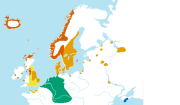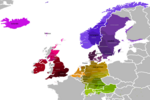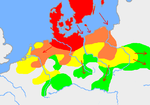transcription delimiters. The Germanic umlaut (sometimes called i-umlaut or i-mutation) is a type of linguistic umlaut in which a back vowel changes to the...
52 KB (5,283 words) - 23:04, 25 March 2024
Ï, lowercase ï, is a symbol used in various languages written with the Latin alphabet; it can be read as the letter I with diaeresis, I-umlaut or I-trema...
4 KB (297 words) - 22:11, 19 May 2024
Look up Umlaut or umlaut in Wiktionary, the free dictionary. Umlaut may refer to: Umlaut (diacritic), a diacritical mark that consists of two dots ( ¨ )...
2 KB (237 words) - 12:53, 1 April 2024
Umlaut (/ˈʊmlaʊt/) is a name for the two dots diacritical mark (◌̈) as used to indicate in writing (as part of the letters ⟨ä⟩, ⟨ö⟩, and ⟨ü⟩) the result...
17 KB (2,022 words) - 12:15, 3 May 2024
Icelandic grammar (section I-umlaut)
of an I-umlaut, but the original vowel in sonur was u changed to o by the A-umlaut.) ú, jú and jó ⇒ ý au ⇒ ey The above effects of the I-umlaut are most...
51 KB (4,697 words) - 09:01, 28 February 2024
Phonological history of Old English (redirect from Palatal umlaut)
(sometimes back umlaut, guttural umlaut, u-umlaut, or velar umlaut) is a change that took place in late prehistoric Old English and caused short e, i and sometimes...
83 KB (8,846 words) - 00:19, 8 March 2024
A metal umlaut (also known as röck döts) is a diacritic that is sometimes used gratuitously or decoratively over letters in the names of mainly hard rock...
13 KB (1,489 words) - 23:14, 14 May 2024
§ Brackets and transcription delimiters. I-mutation (also known as umlaut, front mutation, i-umlaut, i/j-mutation or i/j-umlaut) is a type of sound change in which...
7 KB (874 words) - 15:43, 6 April 2024
umlaut (from German "sound alternation") is a sound change in which a vowel is pronounced more like a following vowel or semivowel. The term umlaut was...
5 KB (592 words) - 08:29, 24 October 2023
caused by i-umlaut of long and short ea, eo, io did not appear in Anglian. Instead, i-umlaut of ea and rare eo is spelled e, and i-umlaut of io remains...
33 KB (3,167 words) - 14:46, 5 March 2024
The vowels /i/ and /ai/ rounded to /y/ and /ey/, respectively, only before /w/. Short /a/ become /ø/ by a combination of i-umlaut and w-umlaut. A process...
92 KB (9,397 words) - 22:20, 10 May 2024
Old English grammar (section i-stems)
constructions characteristic of the Germanic daughter languages such as the umlaut. Among living languages, Old English morphology most closely resembles that...
84 KB (8,358 words) - 16:49, 20 May 2024
Double acute accent (redirect from Hungarian umlaut)
well as length. Later í, ó, ú were marked as well. In the 18th century, before Hungarian orthography became fixed, u and o with umlaut + acute (ǘ, ö́) were...
10 KB (871 words) - 00:20, 22 February 2024
by a mix of inflection and two nonconcatenative morphological processes: umlaut, a backness-based alteration to the root vowel; and ablaut, a replacement...
69 KB (4,986 words) - 05:42, 6 January 2024
Two dots (diacritic) (section Umlaut)
The most familiar to English-language speakers are the diaeresis and the umlaut, though there are numerous others. For example, in Albanian, ë represents...
25 KB (2,942 words) - 08:15, 11 May 2024
"Ha(þu)þ[e]was ann k(u)sjam log(u)ns", interpreting it as "[property] of Haþuþewaz. I bestow upon the choosers of the swords". Old Dutch is the language ancestral...
16 KB (1,616 words) - 04:29, 22 February 2024
Ossetic has Digoron erä, irä, Iron ir, with Dig. iriston, Iron iryston (the i-umlaut modifying the vowel a-, but leaving the -r- untouched), [and] the ancestral...
85 KB (9,837 words) - 09:54, 8 May 2024
German alphabet (section Umlaut diacritic usage)
alphabet: German uses letter-diacritic combinations (Ä/ä, Ö/ö, Ü/ü) using the umlaut and one ligature (ẞ/ß (called eszett (sz) or scharfes S, sharp s)), but...
17 KB (2,020 words) - 11:16, 1 May 2024
the mid front rounded vowel /ø(ː)/, spelled ⟨œ⟩, which had emerged from i-umlaut of /o(ː)/. In West Saxon and Kentish, it had already merged with /e(ː)/...
90 KB (8,308 words) - 19:10, 4 May 2024
Clinton McKinnon (musician) (redirect from Ümlaut (band))
Part Thomas Edison. Bär McKinnon performs around Melbourne with his band Umläut and contributes to a remote supergroup formed in 2020 by the name of High...
13 KB (1,398 words) - 02:39, 19 January 2024
Gothic language (section Lack of umlaut)
contain the characteristic change /u/ > /iː/ (English), /uː/ > /yː/ (German), /oː/ > /øː/ (ON and Danish) due to i-umlaut; the Gothic form shows no such change...
92 KB (9,677 words) - 00:38, 21 May 2024
Subjunctive mood (redirect from Konjunktiv I)
the past with *-ī-. In German, these forms have been reduced to a schwa, spelled -e. The past tense, however, often displays i-umlaut. In Old Norse, both...
87 KB (9,852 words) - 00:11, 10 May 2024
*dōmijaną). The umlauts are divided into three categories: a-umlaut, i-umlaut and u-umlaut; the last was still productive in Old Norse. The first, however...
22 KB (2,296 words) - 17:27, 17 April 2024
The ʾimāla is of the i-umlaut type. Distinctive pronouns are 2sg.f. suffix -ke. The a-Type perfects take the form ḍarōb and the i-type lbēs. The suffix...
11 KB (1,132 words) - 22:17, 29 March 2024
Palatalization postdated fronting, and predated monophthongization and i-umlaut. Between vowels, h generally disappears (sian from *sehwaną), as in Old...
14 KB (1,060 words) - 19:48, 16 May 2024
geba, OE giefe (unstressed a > e) vs. Gothic gibōs. The development of i-umlaut. The rhotacism of /z/ to /r/, with presumably a rhotic fricative of some...
57 KB (5,429 words) - 10:22, 25 March 2024













